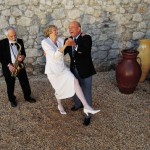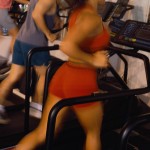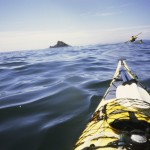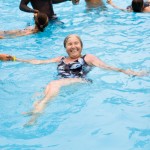 Question: What exercises can I do while my kids are playing at the park? –Bonnie in OH.
Question: What exercises can I do while my kids are playing at the park? –Bonnie in OH.
Answer:
Do a circuit-style workout consisting of six exercises. Each exercise should be done for 30 seconds or 15 reps each. After completing one exercise, move right into the next exercise without rest. After all six exercises are complete, take a 60 second rest. Beginners should stop the workout after one circuit and move right into the cool down. Progress to performing three circuits of all six exercises for a 30 Minute Park Workout.
Start warming up your muscles by taking a 5 minute walk or light jog around the park.
Platform Pushups
Find a platform that is about waist high, for example a step on the jungle gym. Place your hands about shoulder width apart on the platform. Keeping the back flat, core tight and hips down, perform a pushup.
Bench Step Ups
Using a bleacher or a bench, step up on to it with your left foot. Use and up, up, down, down cadence. After 30 seconds, switch and step up starting with your right leg.
Plank
To get into the plank position, start on elbows and knees, locking hands together. Straighten legs and raise your body so that you’re supported by the balls of your feet, with feet hip-distance apart. Face the ground, being careful not to arch your back or lift your hips.
Walking Lunges
With your right leg, lunge forward about three feet until your right thigh is parallel to the ground and your left knee is nearly touching the ground. Pause momentarily and then repeat the forward motion with your left leg. Lunge forward for 30 seconds and turn around and lunge back the way you came. To make this exercise harder, try doing the walking lunges up a hill.
Bench Dips
To do the bench dip, go back to your bleacher or park bench and have a seat. Grab the edge of the bench keeping your hands close to your hips. Walk your feet forward slightly until your hips are off of the platform and your knees are at a 90 degree angle. Bending your shoulders and elbows, drop your hips straight down towards the floor about six inches. Push yourself back up.
Hanging Abs
Hang from the high monkey bars, arms bent or straight. Pull your knees up towards your chest and then lower them back to your starting position. Be sure to keep the movement slow and controlled. Remember – this is an ab exercise, so your abs should be doing the work, not the legs. Try not to use the momentum and swing the legs.
Walk around the park for 5 minutes at a slow pace to cool down. Finish off the workout by stretching the muscles you just worked.
Tera Busker is an ACE Certified Personal Trainer and owner of Fitness To Go, an exclusive In Home & Private Studio Personal Training Service based out of Roberts, WI. www.fitnesstogo.net
 Subscribe
Subscribe







